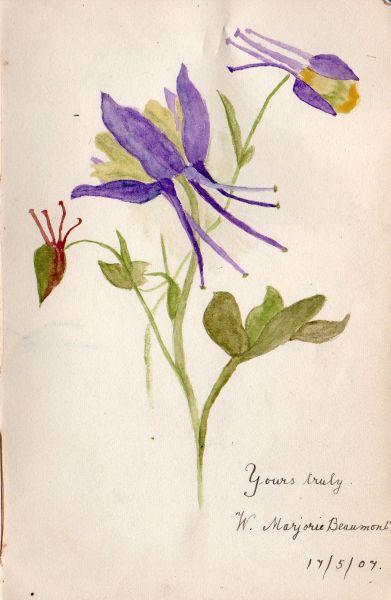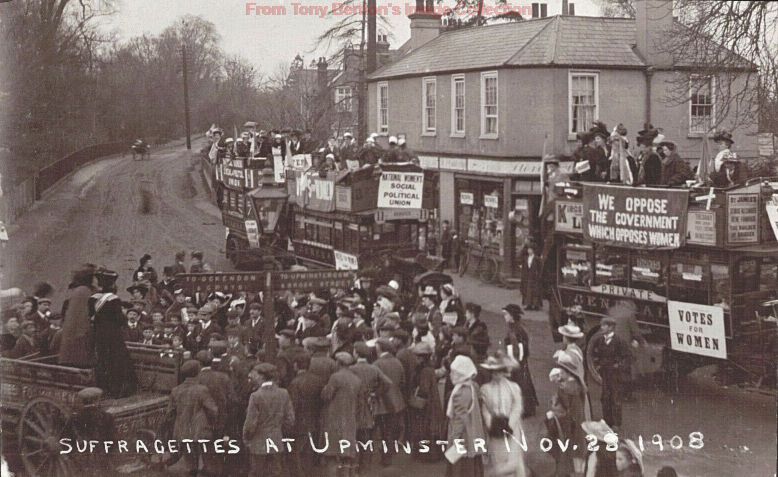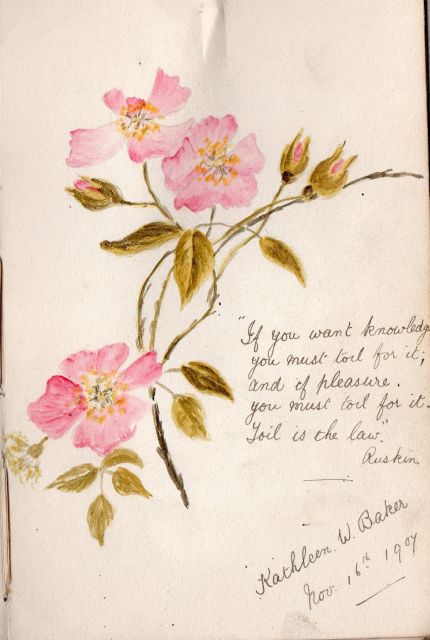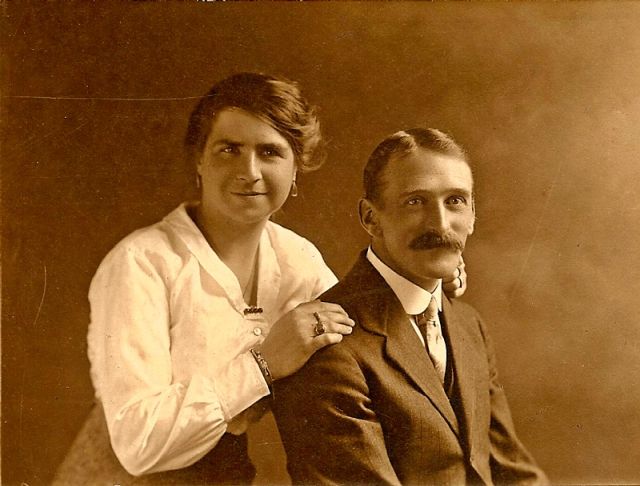Autumn 1906 was an important time for Upminster, as W P Griggs launched his company’s scheme to develop the Upminster Garden Suburb on the southern part of the Upminster Hall Estate that he had bought from the Branfill family. It was also important for an Upminster teenager, Lily Aggiss, who became one of the first students at the newly opened Romford County High School for Girls under headmistress Frances Bardsley.
Lily Aggiss was born on 18th November 1891, the youngest of four children of William Aggiss and Sarah nee Perry. The Aggiss family were well established in Upminster, having lived there since at least 1807 when William’s grandfather, also named William, had married Susannah Cutter at St Laurence’s church. The family lived at Little Gaynes Cottages on what is now known as Little Gaynes Lane, moving to the Post Office Cottages in Corbets Tey Road in the 1870s, which is probably where Lily was born.
Lily’s father, known as “Billy”, was born in Upminster in 1853 and in 1871 census he was shown as a groom. Ten years later he was a coachman, who was later said to have worked for Henry Joslin senior of Hoppy Hall, where until their marriage in 1876, his wife Sarah was said to be the cook. In 1890, one year before Lily’s birth, William put his experience to good use and started his own business as a jobmaster, hiring out cabs, horses and carts from a site behind the Bell Inn, moving his home and businesses premises to the Chestnuts before 1905 . He also supplemented his income by working as a School Attendance Officer for Romford and surrounding areas at an annual salary of £25.

Lily had attended the Upminster Council School, at the former British School buildings on the west side of Station Road, which housed the Girls’ and Infants’ Departments under Headmistress Miss Anne Helena Condy. The school could accommodate 190 students in its cramped buildings, which had been extended in 1885, but attendances only hovered around 120 during Lily’s time as a pupil there. She probably left school on her 14th birthday in November 1905.
It was in the following summer of 1906 that Essex County Council approved plans to set up a County High School for Girls in Romford, appointing the 34-year-old Miss Frances Bardsley as the first Headmistress at a salary of £200 plus £1 for each of the first 50 paying pupils and 10 shillings per paying pupil after that. The County Council took out a lease on Claughton College, a private school in Romford’s Eastern Road and Lily Aggiss was one the County High School’s first intake of pupils when the new school opened there in September 1906.
That Christmas Lily first wrote in an album that she may have received as a present:
Christmas 1906 Notice
Come, look in my album
But learn, ere you look
That all are expected to add to this book;
You may “quiz” it and welcome
But the penalty is:-
You must leave something here
For others to “quiz”
By Order
Lily

James and George Aggiss Archive
Over the course of the next year or so there are numerous entries in the album from friends and family members which give us an insight into Lily’s world.
Seven of her contemporaries at Romford County High School can be identified from their entries in Lily’s album. These girls may have been Lily’s closest friends and along with other students appear in press reports for exam successes of RCHS pupils. Lily and six of these girls (Ethel Gross, Winifred Harrold, Marjorie Beaumont, Maud Hale, Nora Last and Elizabeth Ready) were among nine pupils who were successful in the Cambridge University Junior Local Examinations in the summer of 1908, and another, Lizzie Franklyn, was among those who received the Cambridge Senior Certificate. The entries in Lily’s album for Marjorie Beaumont, Ethel Gross and Elizabeth Ready include illustrations which are of a high standard, showing that art was clearly taught well at the school.

James and George Aggiss Archive
During Lily’s first few years at Romford County High, Upminster hosted two suffragette rallies, one in April 1907 at which two prominent suffragettes Charlotte Despard and Christabel Pankhurst spoke, and the other in November 1908 was chaired by Upminster’s own suffragette Henria Williams whose activities in support of the movement were very visible in the town and which later came to national attention.

The Romford Headteacher Frances Bardsley, who has herself been described as a feminist, was one of a new generation of women who followed a career. Born in December 1871, the daughter of the Rector of Spitalfields, Frances trained as a teacher at the Cambridge Training College, whose principal, Welshwomen Elizabeth Hughes, recommended her for a job at a new school near Swansea in 1896. At the time that Miss Bardsley was appointed headteacher in Romford in 1906 she was teaching at the respected Bolton High School for Girls. Teaching was becoming a more respected and better trained profession and it was only natural that the girls under Miss Bardsley’s charge were encouraged to have a career themselves. The evidence is that she successfully did this, as many of her pupils themselves became teachers. The Romford School site also included a pupil-teacher training centre where pupils aged 16 of “suitable character”, who had passed the examination of the Board of Education and another approved exam, could serve a two-year apprenticeship which involved spending half their time in the school and their other half learning how to teach.

Lily seems to have followed this route and spent two further years as a County High pupil, leaving in summer 1910, having passed the Cambridge Senior examination, the certificates from the London Institute for the Advancement of Needlework, and the Royal Drawing Society, as well as receiving her Hockey colours. These certificates were presented to Lily at the end of March 1911 at the school’s annual speech day, held at the new school premises in Heath Park, which had opened at the start of the 1910-11 school year. A few days later, the 1911 census shows Lily as a student teacher living with her parents at the Chestnuts.
Lily’s album shows entries from members of her immediate and extended family and from others within the family’s local social circle. There are two entries from her cousin Victor Lavender, the son of Lily’s aunt Annie Aggiss who was married to Thomas Nathaniel Lavender, who had a butchers’ shop in Upminster, initially at Cosy Corner from March 1887 and then from 1899 in premises which he had built nearby on Station Road. Lily’s older brother Henry James Aggiss married another member of the Lavender family Cecilia, who wrote in Lily’s album in 1907, seven years before her marriage and move to Upminster. Lily’s sister Annie, ten years her senior, wrote an entry in 1907, two years before her marriage to Walter John “Jack” Knight, of Sullens Farm. Jack also made an entry, as did his sister Edith Annie (“Edie”) Knight who married Ernest Hills – their children Peter and Joan Hills wrote memoires of growing up in Upminster in Upminster in Living Memory.

Seated: L to R: Lily Aggiss, Emma (“Bet”) Knight, William Aggiss, Sarah Aggiss, Annie Aggiss, “Jack” Knight, Annie Knight, Walter Knight, Ellen (“Nell”) Aggiss & Edith (“Edie”) Knight
Standing: Centre behind the bride & groom: Henry James Aggiss
James & George Aggiss Archive
Lily’s autograph book also includes entries from sisters Edith and Celestine Pearmain, both of whom were teachers, daughters of Edmund Pearmain, carpenter of Cranham Road (later St Mary’s Lane) and another Upminster teacher Ethel Abraham, daughter of Thomas Abraham, of the mill owning Upminster family. Another teacher to sign Lily’s album was Constance (Connie) Eldred, daughter of Samuel Eldred, the last member of the Eldred family to operate the smithy adjacent to the Bell Hotel. Entries were also added by sisters Catherine and Lilian (Lily) Hook, daughters of local builder William Hook, who had been T L Wilson’s business partner, who lived at Oakhurst in Station Road (later the site of Talbot’s garage). It’s hardly surprising that Lily’s circle included members of the Eldred family, who had been blacksmiths in Upminster from 1799 until 1906, nor the Hooks, who like the Aggiss family had also been in Upminster for more than a century by this time.
Just weeks after Lily started at Romford County High in 1906, W P Griggs received consent from the Romford Rural District Council for his company W P Griggs & Co to develop the “Upminster Garden Suburb” on some 150 acres of the Upminster Hall Estate which he had bought from the Branfill family trustees. The first bricks were laid on 17 November 1906, with the earliest properties being detached houses on Hall Lane and Waldegrave Gardens, to the designs of the Company’s architect Mr George Verlyck. The new shopping parade on the east side of Station Road and houses in St Lawrence Road followed from 1907. Within a few short years the rural village where Lily had been born and grown up was transformed and we can’t imagine what established families like the Eldreds. Hooks and Aggisses thought about this transformation.
Lily’s album shows that she also had Hornchurch connections. These included Winifred Pearce, later Headmistress of Hornchurch Infants School (now Langton’s School), who was the daughter of Thomas Pearce, blacksmith of Hornchurch High Street, Dora Perfect, the daughter of Charles Thomas Perfect, the Hornchurch local historian of Station Lane, Hornchurch, and Kathleen Baker, daughter of Charles Henry Baker, the Hornchurch grocer and draper, and his wife Jessie, daughter of George Rowe of Upminster.

James and George Aggiss Archive
Like other similarly sized villages the onset of war in 1914 changed Upminster life. The newly built St Lawrence Hall was quickly converted to serve as a Voluntary Aid Detachment (VAD) Hospital for recovering servicemen. Lily was now 22. Many Upminster men of her generation and acquaintance, enlisted. Some lost their lives or were invalided out with permanent physical and/or mental wounds. Others returned apparently unscathed.
At the start of April 1916, just a few days after the death of Lily’s mother Sarah, the 2/1st Battalion of the Royal Bucks Hussars arrived in Upminster, encamped at what is now Upminster Park, Hall Lane staying for the next twelve weeks. The local population welcomed them by opening the boys’ and girls’ school buildings each evening as a recreation or YMCA Room. Some residents, including the Aggiss family, entertained soldiers in their homes. One of these arrivals, Trooper George Tipping, a 21-year-old from Slough, nicknamed “Tip”, seems to have become friendly with Lily and her older sister Ellen, known as Nell or Nellie. It seems that he was particularly fond of Nell, his senior by six years, and in June 1916 he wrote a flattering rhyme in Nell’s own autograph album before the troop left Upminster for their next billet at Thorndon Park, Brentwood. Although nothing seems to have come of this brief flirtation, it’s likely that the extended Aggiss family locals made a favourable impression on “Tip” as, after he was demobbed at the end of the war, he came back to Upminster to lodge with Nell and Lily’s brother-in-law Jack Knight at Sullens Farm, while working for Jack’s father Walter Knight at Park Corner Farm, Hacton. Tip stayed on in Essex, later marrying and settling in the county.

Lily’s brother Henry, who had married Cecilia Lavender on 6th July 1914, 22 days before the outbreak of war, voluntarily enlisted in the Royal Army Service Corps. Grand-daughters, Eve, Jane and Sarah recall that following his enlistment, Henry cut his King’s Shilling in half. He gave his new wife one side and took the other with him to the battlefields of France, in the hope that the two pieces would be reunited when hostilities ended. After his safe return he invested his demobilisation money into an old Thorneycroft truck, which allowed the family business at the Chestnuts to expand.

Lily taught at the Girls’ School, in the former British School buildings, part of the Upminster Council School, for almost 15 years until her untimely death at the age of only 33 on 25th April 1925. The official cause of death was “Exopthalmic goitre” and “acute thyroidism”. A goitre, or enlarged thyroid gland, was a common and increasing complaint in the 1920s, often resulting in death, as it did for Lily. Common symptoms were heart palpitations, an overactive thyroid gland and prominent eyeballs.
She was buried in St Laurence Churchyard five days later in a ceremony conducted by the Rev Henry Hyla Holden. The press accounts of her funeral said that Lily was “much respected” and that “the widespread sympathy felt for the family was shown by the large congregation”, amongst whom was George Tipping; some 40 “beautiful” floral tributes and wreaths were sent.
Lily’s untimely death saw her outlived by her father William who died in 1939, aged 85, and her older siblings Henry (d.1950), Annie (d.1961) and Nell (d.1964).

James & George Aggiss Archive
With thanks to Eve Higgs formerly Oughton née Aggiss,
Jane Gardiner née Aggiss, and Sarah Kippin née Aggiss
For Frances Bardsley see “Frances Bardsley: the feisty feminist behind all girls secondary school” Professor Ged Martin, Romford Recorder 10 September 2017 https://fbaok.co.uk/our-history/
